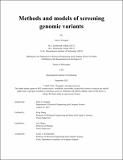| dc.contributor.advisor | Zhang, Feng | |
| dc.contributor.advisor | Regev, Aviv | |
| dc.contributor.author | Frangieh, Chris J. | |
| dc.date.accessioned | 2023-11-02T20:19:08Z | |
| dc.date.available | 2023-11-02T20:19:08Z | |
| dc.date.issued | 2023-09 | |
| dc.date.submitted | 2023-09-21T14:26:27.029Z | |
| dc.identifier.uri | https://hdl.handle.net/1721.1/152824 | |
| dc.description.abstract | Genomes are the basis of human biology and human disease. Understanding the role of each gene on a healthy or diseased phenotype requires an intervention to causally link between genotype and phenotype. Advances in RNA-guided endonucleases have enabled such pooled screens in human cells. I first consider a model to understand drivers of immune evasion in a pooled knockout screen conducted in an in vitro model of metastatic melanoma. Next, I discuss strategies for scaling these screens to encompass a larger set of genes from the human genome. Finally, I explore how next-generation genome editors can move beyond knockout screens to identify the biological role of any sequence at any location in the human genome. | |
| dc.publisher | Massachusetts Institute of Technology | |
| dc.rights | In Copyright - Educational Use Permitted | |
| dc.rights | Copyright retained by author(s) | |
| dc.rights.uri | https://rightsstatements.org/page/InC-EDU/1.0/ | |
| dc.title | Methods and models of screening genomic variants | |
| dc.type | Thesis | |
| dc.description.degree | Ph.D. | |
| dc.contributor.department | Massachusetts Institute of Technology. Department of Electrical Engineering and Computer Science | |
| mit.thesis.degree | Doctoral | |
| thesis.degree.name | Doctor of Philosophy | |
